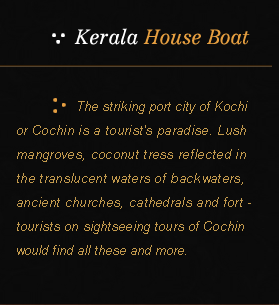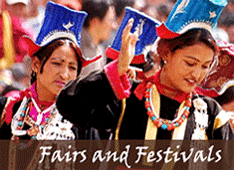Home > India Wildlife Tour > Tiger Safari Tour with Taj & Culture

Duration : 15 Days & 14 Nights
Location : Delhi – Jaipur – Ranthambhore – Bharatpur – Agra – Bandhavgarh – Kanha – Delhi.
Location : Delhi – Jaipur – Ranthambhore – Bharatpur – Agra – Bandhavgarh – Kanha – Delhi.
Day 01
Delhi Arrival:
COMPANY REPRESENTATIVE will receive you on arrival at the DELHI AIRPORT and transfer to your hotel.
DELHI, the capital of kingdoms and empires is now a sprawling metropolis with a fascinating blend of the past and the present. It is a perfect introduction to the composite culture of an ancient land. A window to the kaleidoscope - that is India.
Overnight will be at Delhi.
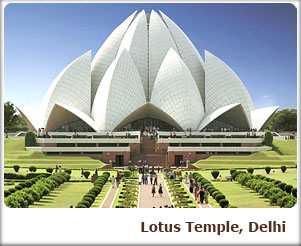 Day 02
Day 02
Delhi – Jaipur:
By Road 260Kms/05hrs
Drive to Jaipur after leisurely breakfast.
Jaipur is the capital of the state of Rajasthan a romantic realm of resplendent palaces, mighty fortresses and regal Maharajahs that lies in the western deserts and is an utterly unique part of India. Proudly belonging to the KSHATRIYA warrior caste and fiercely independent, the Rajput princes made fearsome foes. However, many of them realized that to maintain their wealth and authority locally, it was expedient to proclaim allegiance to the central power. Thus, many enjoyed a privileged position under the Mughal emperors and also the British Raj that followed.
The bustling Rajasthan capital of Jaipur takes its name from its venerated founder Jai Singh II, who was given the title Sawai Maharaja by the Mughal. Literally translated this would mean ’one and a quarter’, suggesting that the Mughal thought this emperor to be more valuable than just ‘one’. Jaipur is known as the ’Pink City’ on account of the distinctive colour of its buildings. This did not, however, form part of the original plan, but dates back to 1856, when the city was given a wash of pink in honor of a State Visit from Prince Albert.
This evening, visit the Birla Temple to learn more about the fascinating religious life of Jaipur. The marble structure, built as recently as 1985, houses ornate statues including one of Lakshmi (goddess of Wealth and Beauty) and Narayan dressed in gaudy robes, representing a Hindu vision of heavenly luxury. Carvings in the temple and on pillars supporting the covered walkways include images of the Hindu pantheon, as well as Jesus, the Blessed Virgin Mary and St Francis of Assisi. Your visit will coincide with the AARTI Ceremony, which involves oil lamps being lit and waved, in order to awake and invoke the deity.
Enjoy the experience and spend night at Jaipur.
Day 03
Jaipur:
After breakfast drive to Amber Palace. Enjoy Elephant Back ascent to the Fort.
AMER PALACE & FORT: Amer Fort and Palace was originally built by Raja Man Singh and subsequently developed by Sawai Jai Singh. The major attractions are Sheela Devi Temple, Sheesh Mahal (Hall of mirrors), Jai Garh Fort a few kilometers from the city centre was built for the defence of the town and has one of the world’s biggest cannons on wheels and a rich collection of arms and weapons.
Continue city sightseeing.
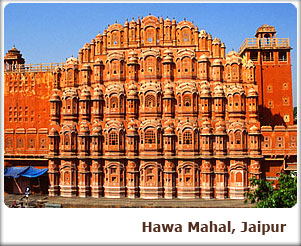 HAWA MAHAL (PALACE OF WINDS): Hawa Mahal is the most strikingly designed monument in Jaipur. Built by the Poet-King Sawai Pratap Singh in 1799, the Hawa Mahal is centrally located and is multiniched five storey high back view of the compled. It was conceived to provide an adequate vantage position behind delicate stone-carved jali, screens for the palace women to watch the royal processions passing through the Bazar below without being seen by outsiders. The Top of the palace affords a beautiful view of the city. A small archaeological museum is yet another attraction in the palace.
HAWA MAHAL (PALACE OF WINDS): Hawa Mahal is the most strikingly designed monument in Jaipur. Built by the Poet-King Sawai Pratap Singh in 1799, the Hawa Mahal is centrally located and is multiniched five storey high back view of the compled. It was conceived to provide an adequate vantage position behind delicate stone-carved jali, screens for the palace women to watch the royal processions passing through the Bazar below without being seen by outsiders. The Top of the palace affords a beautiful view of the city. A small archaeological museum is yet another attraction in the palace.
JAL MAHAL: The Jal Mahal Palace, Jaipur is noted for its intricate architecture. The Palace was developed as a pleasure spot. It was used for the royal duck shooting parties. On the road to Amber at a distance of 6.5 Kms from Jaipur are the cenotaphs of the royal family. A causeway leads to Jal Mahal Palace situated in the middle of Man Sagar Lake, opposite the cenotaphs. The first four floors of this building is under water, only the top floor remains outside. One can have a wonderful view of the lake and the palace from Nahar Garh Fort Built in 1799, the palace is now abandoned, but reasonably well preserved. In the monsoons, it looks particularly startling with its red sandstone set against the water hyacinth filled lake.
THE CITY PALACE: The city Palace is a historic landmark. The Carved arches are supported by grey-white marble columns studded with floral motifs in gold and colored stones. Two elephants carved in marble, guard the entrance, where retainers whose families have served generations of the rulers are at hand, to serve as guides.
JANTAR MANTAR: Jantar Mantar is one of Sawai Jai Singh’s five remarkable observatories. Constructed with stone and marble its compled instruments, whose setting and shapes are precisely and scientifically designed, represent the high-points of medieval Indian Astronomy. The two Ram Yantras used for gauging altitudes are unique in their isolation. This is the largest of five observatories founded by Sawai Jai Singh-II in various parts of the country.
This evening is free for you to relax shop or explore independently. Shopping is superb in Jaipur, particularly for gold and silver jewellery, pottery, tie-dye materials, silk, saris, wooden handicrafts and carpets.
Overnight will be at Jaipur.
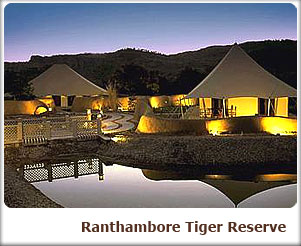 Day 04
Day 04
Jaipur – Ranthambhore:
By Road 170Kms/04hrs
Breakfast will be at the hotel.
Drive to Ranthambhore. Reach and check into the hotel.
Ranthambore National Park is in Sawai Madhopur District of Rajasthan state. Located at the junction of the Aravalli and Vindhya hill range, this is one of the finest places to view animals, especially as they are used to being stared at here. The park covers an area of Approximately 400 sq Km and if combined it with the area of sawai man Singh sanctuary area, it is around 500 Sq km.
Ranthambore national park was declared a wildlife sanctuary in 1957 and in 1974 it gained the protection of "Project Tiger". It got its status of a National Park in 1981. Ranthambore National Park is dotted with structures that remind you of bygone eras. There are many water bodies located all over the park, which provide perfect relief during the extremely hot summer months for the forest inhabitants. A huge fort, after which the park is named, towers over the park atop a hill. There are many ruins of bygone eras scattered all over the jungle, which give it a unique, wonderful and mixed flavor of nature, history and wildlife. Tigers at Ranthambore National park have been known to even hunt in full view of human visitors. These tigers are famous for being seen in the daytime too, due to their lack of fear of human presence in vehicles. This lack of fear of humans is excellent for tourists, as they get to see the tigers often.
This National park is a wildlife enthusiast and photographer's dream. It offers excellent accommodation and internal transportation facilities. The park remains open every year from October to May. Famous for the exciting and frequent tiger sightings captured dramatically in several books, this park is today affected by ecological pressures and poaching.
In Nutshell, Ranthambore National park is a wildlife enthusiast and photographer's dream.
Timings for entry into, and exit from, the park vary according to the season. In winters, due to the shorter duration of daylight hours, the morning entry time is later and evening exit time is earlier.
Overnight will be at Ranthambore.
Day 05
Ranthambhore:
Wake up early morning and leave for your safari into the National Park. Track the tigers and other wildlife through the morning. Return to the resort / lodge by 1000 in the morning and have breakfast.
Freshen up and either spends time at the pool or visit the town. You could also go for a nice visit to the temple on top of the fort.
In the afternoon have lunch and then leave again for you afternoon safari. The safari will be till evening 1700 – 1800 hr and then return to the resort / lodge.
Dinner will be at the resort and retire early for the night.
Overnight will be at Ranthambhore.
Day 06
Ranthambhore – Bharatpur:
By Road 225Kms/05hrs
Breakfast will be at the hotel.
Proceed to Bharatpur. Reach and check into the hotel.
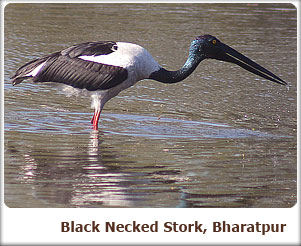 Bharatpur, an erstwhile princely state of the Jat rulers, was founded by the great Maharaja Suraj Mal, who also once conquered Delhi. Maharaja Suraj Mal built the fort at Bharatpur as also the beautiful palaces and gardens at Deeg. The Keoladeo Ghana National Park is one of the finest water-bird sanctuaries in the world. The Maharaja of Bharatpur artificially created the lake and wetland in the 19th century. The marshes of Keoladeo (area 24 sq km, established in 1956 as a bird sanctuary, 1981 as a National Park), were the private hunting reserves of the Maharajas, and was developed in the late 19th century by creating small dams to collect rain water and by feeding it with an irrigation canal. Over the years, the lakes attracted great numbers of waterfowl and the Maharajas held grand shoots with family, friends and visiting dignitaries.
Bharatpur, an erstwhile princely state of the Jat rulers, was founded by the great Maharaja Suraj Mal, who also once conquered Delhi. Maharaja Suraj Mal built the fort at Bharatpur as also the beautiful palaces and gardens at Deeg. The Keoladeo Ghana National Park is one of the finest water-bird sanctuaries in the world. The Maharaja of Bharatpur artificially created the lake and wetland in the 19th century. The marshes of Keoladeo (area 24 sq km, established in 1956 as a bird sanctuary, 1981 as a National Park), were the private hunting reserves of the Maharajas, and was developed in the late 19th century by creating small dams to collect rain water and by feeding it with an irrigation canal. Over the years, the lakes attracted great numbers of waterfowl and the Maharajas held grand shoots with family, friends and visiting dignitaries.
Commonly referred to as Bharatpur, the Park is a delight for bird watchers. Over 375 species of birds are found here and raised paths, camouflaged by babul trees and undergrowth make viewing easy. A quiet ride by boat in the early hours of the morning is also unforgettable experience. The cacophony is unbelievable as painted storks, open bills, spoonbills, egrets, cormorants, white ibis and multitudes of others, tend their young. Jacanas with their iridescent colors and elegant tail feathers and purple moorhen can be seen delicately treading over the floating vegetation.
The Park has over 400 resident and migrant bird species, including the Common, Demoiselle and the rare Siberian Cranes. As well as mammals like Striped Hyena, Fishing Cat, Golden Jackal, Jungle Cat, Nilgai, Sambar, Blackbuck, wild Boar and Indian Python.
Proceed on RICKSHAW for viewing the birds. RICKSHAW PULLERS have been trained by the forest department in bird watching and are knowledgeable.
Overnight will be at Bharatpur.
Day 07
Bharatpur – Agra:
By Road 55Kms/01hr
Enjoy Birding.
Breakfast will be at the hotel.
Drive to Agra visiting Fatehpur Sikri enroute.
FATEHPUR SIKRI – THE CITY OF VICTORY: 37 Kms from the city of Agra, stands Fatehpur Sikri, Akbar’s capital. Full credit goes to the Archeological Survey of India for this perfectly preserved example of a Mughal city at the height of the empire’s splendor. It is an attraction no visitor to Agra should miss. This sprawling structure is made of red sandstone and combines both Hindu and Mughal architecture. This walled city contains the mausoleum of the Sufi fakir, Saleem Chisti who is said to have granted Akbar and his Hindu queen Jodhabai their wish for a son. The main entrance to Fatehpur Sikri is through the 175 feet Buland Darwaza, the highest gateway in the world. It was built by Akbar to commemorate his victory over Khandesh in Gujarat. The Panch Mahal is a five-storeyed tower, the highest point in Fatehpur Sikri. This extremely airy tower is supposed to have been used by one of the emperor's many queens.
Reach Agra and check into the hotel.
AGRA: Two great Mughal monarchs, Akbar and Shah Jahan, transformed the little village of Agra into a befitting second capital of the Mughal Empire – giving it the name Dar-ul-Khilafat {seat of the Emperor}. Today a visitor to Agra is caught up in a world of contrasting edifices, of red sandstone and white marble, narrow galleys and quaint buggies, and that irresistible charm that this favorite city of the Mughals still retains. It is not surprising, that modern Agra still reflects its Mughal heritage most conspicuously. A walk down the narrow bustling streets of the city will introduce the visitor to the wafting aroma of Mughlai cuisine.
Overnight stay will be at Agra.
Day 08
Agra – Umaria:
By Overnight Train
After breakfast proceed for day sightseeing of Agra.
THE TAJ MAHAL – AN EMPEROR’S LAMENT: Agra is the city of the Taj Mahal. It is a sublime experience of the greatest love story ever told. Today India's most fascinating and beautiful masterpiece, this perfectly symmetrical edifice is set amidst landscaped gardens on the banks of the Yamuna River. The Taj was built by the Mughal Emperor Shahjahan as a memorial to his wife, Mumtaz Mahal. After her untimely death, Shah Jahan had her mortal remains buried in this mausoleum. And after his own demise he was placed to rest next to his beloved queen in the same mausoleum. Under the dome, below the ground level, in a dimly lit chamber, lie the mortal remains of Shahjahan and his beloved queen Mumtaz, reminding the world of their undying love. The Taj remains closed for visitors on Friday
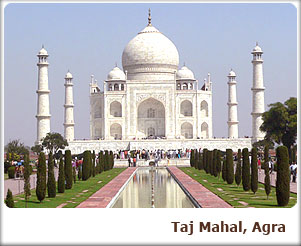 AGRA FORT – ARCHITECTURAL WONDER IN STONE: Within a radius of 3 kilometers, on the banks of the river Yamuna raises the crescent like Agra Fort. Designed and built by Akbar in 1565 A.D., the fort is surrounded by a 70 feet high wall. It houses the beautiful Pearl Mosque and numerous palaces including the Jahangir Mahal, Diwan-i-Khas, Diwan-i-Am and Moti Masjid. Later it was used by his son Jahangir also as the seat of power. Shahjahan modeled his creation, the Red Fort at Delhi on this fort. The Agra fort happens to be on the same bank of the river Yamuna as the Taj Mahal which is visible in all its beauty from one side of the fort. So very ironically, Shahjahan, a prisoner of his son Aurangzeb in his old age was put in a cell from where he could gaze at the Taj Mahal at a distance, from his cell in the Agra Fort.
AGRA FORT – ARCHITECTURAL WONDER IN STONE: Within a radius of 3 kilometers, on the banks of the river Yamuna raises the crescent like Agra Fort. Designed and built by Akbar in 1565 A.D., the fort is surrounded by a 70 feet high wall. It houses the beautiful Pearl Mosque and numerous palaces including the Jahangir Mahal, Diwan-i-Khas, Diwan-i-Am and Moti Masjid. Later it was used by his son Jahangir also as the seat of power. Shahjahan modeled his creation, the Red Fort at Delhi on this fort. The Agra fort happens to be on the same bank of the river Yamuna as the Taj Mahal which is visible in all its beauty from one side of the fort. So very ironically, Shahjahan, a prisoner of his son Aurangzeb in his old age was put in a cell from where he could gaze at the Taj Mahal at a distance, from his cell in the Agra Fort.
The fort has four gates and is enclosed by a double barricaded wall of red sand stone. Many buildings were constructed within the fort of which very few remain till date. One of the most significant ones is the multi storied Jahangir Mahal built by Akbar for his wife Jodha Bai. The Mahal is reached through an impressive gateway and its inner courtyard consists of beautiful halls, profuse carvings on stone, exquisitely carved heavy brackets, piers and cross beams.
SIKANDRA: Sikandra, 10 Kms North West of Agra, is the final resting place of Emperor Akbar. The Tomb of Akbar shows an interesting fusion of Hindu and Mughal architecture reflecting the spirit of the Mughal Emperor Akbar. Akbar began the construction of his own garden mausoleum during his lifetime, a red sandstone structure in a char-Bagh meaning 4-square formal garden.
ITMAD – UL – DAULAH’A TOMB: This tomb was erected by Nur Jahan in sweet memory of her father Ghiasud-Din-Beg between 1622-1628 A.D. This white marble structure of the pre-Taj era though smaller is often considered equal if not better to the great one itself.
Transfer to the railway station to board overnight train for Umaria.
Day 09
Umaria – Bandhavgarh:
By Road 35Kms/30minutes
Reach Umaria and drive to Bandhavgarh. Reach and check into the hotel.
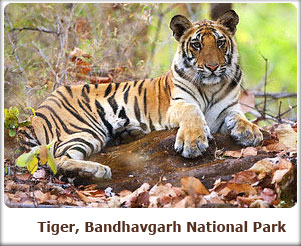 Bandhavgarh National Park is located in Umaria district on the extreme north- eastern border of Madhya Pradesh. Although Bandhavgarh is a small forest reserve, in the last few years, it has become one of the most prominent National Parks, owing to the high density of its tiger population. The mixed forests of Sal and bamboo and the abundance of water and prey create a very conducive atmosphere for the tiger population here. Bandhavgarh was declared a National Park in 1968 with an area of 105 sq. kilometres. The park is open from October to June every year and closed during the monsoons. There are three ways of exploring the forest here: vans, open jeeps or on elephants back. Apart from tigers you can also see sambar, chital, chinkara, barking deer, wild boar, leopard, and sloth bears.
Bandhavgarh National Park is located in Umaria district on the extreme north- eastern border of Madhya Pradesh. Although Bandhavgarh is a small forest reserve, in the last few years, it has become one of the most prominent National Parks, owing to the high density of its tiger population. The mixed forests of Sal and bamboo and the abundance of water and prey create a very conducive atmosphere for the tiger population here. Bandhavgarh was declared a National Park in 1968 with an area of 105 sq. kilometres. The park is open from October to June every year and closed during the monsoons. There are three ways of exploring the forest here: vans, open jeeps or on elephants back. Apart from tigers you can also see sambar, chital, chinkara, barking deer, wild boar, leopard, and sloth bears.
The Park is spread over an area of 437 sq. km. The terrain is made of rocky hills, sal forests and grazing areas, formerly agricultural land. The finest of these hills is the Bandhavgarh hill, and on its highest point stands Bandhavgarh Fort. Though no records remain to show when the fort was constructed, it is believed to be about 2000 years old. Several dynasties have ruled the fort: for example, the Maghas from the 1st century A.D, the Vakatakas from the 3rd century; the Sengars from the 5th century, and the Kalachuris from the 10th century. The oldest signs of habitation are the caves dug into the sandstone, near the fort. Several of these contain Brahmi inscriptions dating from the 1st century B.C. Prior to becoming a National Park, the forest range around the region had been maintained as a Shikargarh, or game preserve, of the Maharajahs of Rewa. It was only in 1968, that the area was declared as a National Park. Since then, stringent steps have been taken to retain it as an unspoilt natural habitat. The fort now is the private property of the Maharaja of Rewa and prior permission is required to visit it. A one hour trek leads up to the fort and the track is dotted by the small temples of the 12th century, unspoiled forests, and small meandering streams.
There are more than 22 species of mammals, and 250 species of birds. Some of the inhabitants of this park are the rhesus macaque, the black-faced langur, jungle cats, chinkara, black buck, munjtac and the chital. The Park attracts many migratory birds in the winter months that include the steppe eagle and a variety of wildfowl. Reptilian fauna include cobra, krait, python, turtle and a variety of lizards. The Bandhavgarh National Park has excellent game and bird viewing to offer, coupled with a fascinating historical element to it, thus satiating those adventurous at heart, completely.
The park can be explored on elephant back (also, a much preferred means of tiger-tracking) or in a vehicle. Jeep safaris are best undertaken, from dawn till about 10a.m, and from 4 p.m till dusk, as the animals are quite active during these periods.
Overnight will be at Bandhavgarh.
Day 10
Bandhavgarh:
Breakfast will be at the hotel.
Proceed for full day game viewing inside the jungle. (Two safaris with lunch break in-between).
Overnight will be at Bandhavgarh.
Day 11
Bandhavgarh:
Breakfast will be at the hotel.
Proceed for full day game viewing inside the jungle. (Two safaris with lunch break in-between).
Overnight will be at Bandhavgarh.
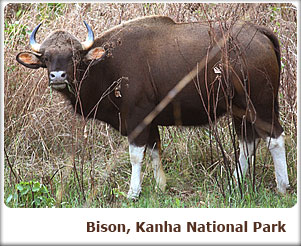 Day 12
Day 12
Bandhavgarh – Kanha:
By Road 255Kms/06hrs
Breakfast will be at the hotel.
Drive to Kanha. Reach and check into the hotel.
A land that inspired Rudyard Kipling to write his classic novel 'Jungle Book', the forested areas of Kanha, with their wild thickets of sal and bamboo forests, rolling meadows and dramatic ravines, are home to the Kanha National Park. The Created in 1955, the national park is today the core area of the Kanha Tiger Reserve, which came into being in 1974, under Project Tiger. The Banjar and the Halon valley form the two halves constituting the vast stretches of land that is the Kanha Tiger Reserve.
One of the greatest achievements of this park is perhaps its contribution in saving many endangered wildlife species, which nearly bordered extinction. The park today steadfastly guards the different genus of wildlife it domiciles and follows painstaking measures to maintain the overall protection of its flora, fauna and avifauna. The popular 'Sunset Point' or 'Bamni Dadar' inside the park is the best lookout point that allows visitors to soak the beautiful landscape of the park and relish rare sights of wildlife viewing.
Wildlife: Trailing a wild tiger lazing around the shades of the forests of Kanha offers its own charm. In fact, the tigers remain the most exciting draw of the place. The park is also home to Sambars and Gaurs, which are generally seen in the green meadows, grazing away the grasses to glory. Animals like blackbuck and chital are also common sights. Other main wildlife attractions of the park include bison, barasingha, barking deer, black deer, chousingha, nilgai, mouse deer, sloth bear, jackal fox, porcupine, hyena, jungle cat, python, mongoose, and leopard.
Avifauna: Apart from the many species of animals that contribute to the wealth of fauna of this jungled beauty, one can also notice a wide variety of exotic birds here. Avifauna of the park include bird species like storks, peacocks, teals, pintails, pond herons, egrets, pea fowl, jungle fowl, spur fowl, papihas, partridges, ring doves, quails, spotted parakeets, green pigeons, rock pigeons, cuckoos, rollers, bee-eater, hoopoes, drongos, warblers, kingfishers, woodpeckers, finches, orioles, owls, and fly catchers. Thus, the place is indeed an ornithological wonder and a paradise for all bird watchers.
Overnight will be at Kanha.
Day 13
Kanha:
Breakfast will be at the hotel.
Proceed for full day game viewing inside the jungle. (Two safaris with lunch break in-between).
Overnight will be at Kanha.
Day 14
Kanha – Jabalpur:
By Road 195Kms/04hrs
Jabalpur – Delhi:
By Air
Breakfast will be at the hotel.
Drive to Jabalpur airport to take flight for Delhi. Reach and check into the hotel.
Enjoy last minute shopping.
Overnight will be at Delhi.
Day 15
Delhi – Departure:
Morning enjoy the breakfast.
As per your INTERNATIONAL FLIGHT TIMINGS you’ll be transferred to the airport to take your flight back home with sweet memories of TIGER SAFARI TOUR.
...........................................................................TOUR ENDS...........................................................................
INCLUSIONS:
Delhi Arrival:
COMPANY REPRESENTATIVE will receive you on arrival at the DELHI AIRPORT and transfer to your hotel.
DELHI, the capital of kingdoms and empires is now a sprawling metropolis with a fascinating blend of the past and the present. It is a perfect introduction to the composite culture of an ancient land. A window to the kaleidoscope - that is India.
Overnight will be at Delhi.
 Day 02
Day 02 Delhi – Jaipur:
By Road 260Kms/05hrs
Drive to Jaipur after leisurely breakfast.
Jaipur is the capital of the state of Rajasthan a romantic realm of resplendent palaces, mighty fortresses and regal Maharajahs that lies in the western deserts and is an utterly unique part of India. Proudly belonging to the KSHATRIYA warrior caste and fiercely independent, the Rajput princes made fearsome foes. However, many of them realized that to maintain their wealth and authority locally, it was expedient to proclaim allegiance to the central power. Thus, many enjoyed a privileged position under the Mughal emperors and also the British Raj that followed.
The bustling Rajasthan capital of Jaipur takes its name from its venerated founder Jai Singh II, who was given the title Sawai Maharaja by the Mughal. Literally translated this would mean ’one and a quarter’, suggesting that the Mughal thought this emperor to be more valuable than just ‘one’. Jaipur is known as the ’Pink City’ on account of the distinctive colour of its buildings. This did not, however, form part of the original plan, but dates back to 1856, when the city was given a wash of pink in honor of a State Visit from Prince Albert.
This evening, visit the Birla Temple to learn more about the fascinating religious life of Jaipur. The marble structure, built as recently as 1985, houses ornate statues including one of Lakshmi (goddess of Wealth and Beauty) and Narayan dressed in gaudy robes, representing a Hindu vision of heavenly luxury. Carvings in the temple and on pillars supporting the covered walkways include images of the Hindu pantheon, as well as Jesus, the Blessed Virgin Mary and St Francis of Assisi. Your visit will coincide with the AARTI Ceremony, which involves oil lamps being lit and waved, in order to awake and invoke the deity.
Enjoy the experience and spend night at Jaipur.
Day 03
Jaipur:
After breakfast drive to Amber Palace. Enjoy Elephant Back ascent to the Fort.
AMER PALACE & FORT: Amer Fort and Palace was originally built by Raja Man Singh and subsequently developed by Sawai Jai Singh. The major attractions are Sheela Devi Temple, Sheesh Mahal (Hall of mirrors), Jai Garh Fort a few kilometers from the city centre was built for the defence of the town and has one of the world’s biggest cannons on wheels and a rich collection of arms and weapons.
Continue city sightseeing.
 HAWA MAHAL (PALACE OF WINDS): Hawa Mahal is the most strikingly designed monument in Jaipur. Built by the Poet-King Sawai Pratap Singh in 1799, the Hawa Mahal is centrally located and is multiniched five storey high back view of the compled. It was conceived to provide an adequate vantage position behind delicate stone-carved jali, screens for the palace women to watch the royal processions passing through the Bazar below without being seen by outsiders. The Top of the palace affords a beautiful view of the city. A small archaeological museum is yet another attraction in the palace.
HAWA MAHAL (PALACE OF WINDS): Hawa Mahal is the most strikingly designed monument in Jaipur. Built by the Poet-King Sawai Pratap Singh in 1799, the Hawa Mahal is centrally located and is multiniched five storey high back view of the compled. It was conceived to provide an adequate vantage position behind delicate stone-carved jali, screens for the palace women to watch the royal processions passing through the Bazar below without being seen by outsiders. The Top of the palace affords a beautiful view of the city. A small archaeological museum is yet another attraction in the palace. JAL MAHAL: The Jal Mahal Palace, Jaipur is noted for its intricate architecture. The Palace was developed as a pleasure spot. It was used for the royal duck shooting parties. On the road to Amber at a distance of 6.5 Kms from Jaipur are the cenotaphs of the royal family. A causeway leads to Jal Mahal Palace situated in the middle of Man Sagar Lake, opposite the cenotaphs. The first four floors of this building is under water, only the top floor remains outside. One can have a wonderful view of the lake and the palace from Nahar Garh Fort Built in 1799, the palace is now abandoned, but reasonably well preserved. In the monsoons, it looks particularly startling with its red sandstone set against the water hyacinth filled lake.
THE CITY PALACE: The city Palace is a historic landmark. The Carved arches are supported by grey-white marble columns studded with floral motifs in gold and colored stones. Two elephants carved in marble, guard the entrance, where retainers whose families have served generations of the rulers are at hand, to serve as guides.
JANTAR MANTAR: Jantar Mantar is one of Sawai Jai Singh’s five remarkable observatories. Constructed with stone and marble its compled instruments, whose setting and shapes are precisely and scientifically designed, represent the high-points of medieval Indian Astronomy. The two Ram Yantras used for gauging altitudes are unique in their isolation. This is the largest of five observatories founded by Sawai Jai Singh-II in various parts of the country.
This evening is free for you to relax shop or explore independently. Shopping is superb in Jaipur, particularly for gold and silver jewellery, pottery, tie-dye materials, silk, saris, wooden handicrafts and carpets.
Overnight will be at Jaipur.
 Day 04
Day 04 Jaipur – Ranthambhore:
By Road 170Kms/04hrs
Breakfast will be at the hotel.
Drive to Ranthambhore. Reach and check into the hotel.
Ranthambore National Park is in Sawai Madhopur District of Rajasthan state. Located at the junction of the Aravalli and Vindhya hill range, this is one of the finest places to view animals, especially as they are used to being stared at here. The park covers an area of Approximately 400 sq Km and if combined it with the area of sawai man Singh sanctuary area, it is around 500 Sq km.
Ranthambore national park was declared a wildlife sanctuary in 1957 and in 1974 it gained the protection of "Project Tiger". It got its status of a National Park in 1981. Ranthambore National Park is dotted with structures that remind you of bygone eras. There are many water bodies located all over the park, which provide perfect relief during the extremely hot summer months for the forest inhabitants. A huge fort, after which the park is named, towers over the park atop a hill. There are many ruins of bygone eras scattered all over the jungle, which give it a unique, wonderful and mixed flavor of nature, history and wildlife. Tigers at Ranthambore National park have been known to even hunt in full view of human visitors. These tigers are famous for being seen in the daytime too, due to their lack of fear of human presence in vehicles. This lack of fear of humans is excellent for tourists, as they get to see the tigers often.
This National park is a wildlife enthusiast and photographer's dream. It offers excellent accommodation and internal transportation facilities. The park remains open every year from October to May. Famous for the exciting and frequent tiger sightings captured dramatically in several books, this park is today affected by ecological pressures and poaching.
In Nutshell, Ranthambore National park is a wildlife enthusiast and photographer's dream.
Timings for entry into, and exit from, the park vary according to the season. In winters, due to the shorter duration of daylight hours, the morning entry time is later and evening exit time is earlier.
Overnight will be at Ranthambore.
Day 05
Ranthambhore:
Wake up early morning and leave for your safari into the National Park. Track the tigers and other wildlife through the morning. Return to the resort / lodge by 1000 in the morning and have breakfast.
Freshen up and either spends time at the pool or visit the town. You could also go for a nice visit to the temple on top of the fort.
In the afternoon have lunch and then leave again for you afternoon safari. The safari will be till evening 1700 – 1800 hr and then return to the resort / lodge.
Dinner will be at the resort and retire early for the night.
Overnight will be at Ranthambhore.
Day 06
Ranthambhore – Bharatpur:
By Road 225Kms/05hrs
Breakfast will be at the hotel.
Proceed to Bharatpur. Reach and check into the hotel.
 Bharatpur, an erstwhile princely state of the Jat rulers, was founded by the great Maharaja Suraj Mal, who also once conquered Delhi. Maharaja Suraj Mal built the fort at Bharatpur as also the beautiful palaces and gardens at Deeg. The Keoladeo Ghana National Park is one of the finest water-bird sanctuaries in the world. The Maharaja of Bharatpur artificially created the lake and wetland in the 19th century. The marshes of Keoladeo (area 24 sq km, established in 1956 as a bird sanctuary, 1981 as a National Park), were the private hunting reserves of the Maharajas, and was developed in the late 19th century by creating small dams to collect rain water and by feeding it with an irrigation canal. Over the years, the lakes attracted great numbers of waterfowl and the Maharajas held grand shoots with family, friends and visiting dignitaries.
Bharatpur, an erstwhile princely state of the Jat rulers, was founded by the great Maharaja Suraj Mal, who also once conquered Delhi. Maharaja Suraj Mal built the fort at Bharatpur as also the beautiful palaces and gardens at Deeg. The Keoladeo Ghana National Park is one of the finest water-bird sanctuaries in the world. The Maharaja of Bharatpur artificially created the lake and wetland in the 19th century. The marshes of Keoladeo (area 24 sq km, established in 1956 as a bird sanctuary, 1981 as a National Park), were the private hunting reserves of the Maharajas, and was developed in the late 19th century by creating small dams to collect rain water and by feeding it with an irrigation canal. Over the years, the lakes attracted great numbers of waterfowl and the Maharajas held grand shoots with family, friends and visiting dignitaries. Commonly referred to as Bharatpur, the Park is a delight for bird watchers. Over 375 species of birds are found here and raised paths, camouflaged by babul trees and undergrowth make viewing easy. A quiet ride by boat in the early hours of the morning is also unforgettable experience. The cacophony is unbelievable as painted storks, open bills, spoonbills, egrets, cormorants, white ibis and multitudes of others, tend their young. Jacanas with their iridescent colors and elegant tail feathers and purple moorhen can be seen delicately treading over the floating vegetation.
The Park has over 400 resident and migrant bird species, including the Common, Demoiselle and the rare Siberian Cranes. As well as mammals like Striped Hyena, Fishing Cat, Golden Jackal, Jungle Cat, Nilgai, Sambar, Blackbuck, wild Boar and Indian Python.
Proceed on RICKSHAW for viewing the birds. RICKSHAW PULLERS have been trained by the forest department in bird watching and are knowledgeable.
Overnight will be at Bharatpur.
Day 07
Bharatpur – Agra:
By Road 55Kms/01hr
Enjoy Birding.
Breakfast will be at the hotel.
Drive to Agra visiting Fatehpur Sikri enroute.
FATEHPUR SIKRI – THE CITY OF VICTORY: 37 Kms from the city of Agra, stands Fatehpur Sikri, Akbar’s capital. Full credit goes to the Archeological Survey of India for this perfectly preserved example of a Mughal city at the height of the empire’s splendor. It is an attraction no visitor to Agra should miss. This sprawling structure is made of red sandstone and combines both Hindu and Mughal architecture. This walled city contains the mausoleum of the Sufi fakir, Saleem Chisti who is said to have granted Akbar and his Hindu queen Jodhabai their wish for a son. The main entrance to Fatehpur Sikri is through the 175 feet Buland Darwaza, the highest gateway in the world. It was built by Akbar to commemorate his victory over Khandesh in Gujarat. The Panch Mahal is a five-storeyed tower, the highest point in Fatehpur Sikri. This extremely airy tower is supposed to have been used by one of the emperor's many queens.
Reach Agra and check into the hotel.
AGRA: Two great Mughal monarchs, Akbar and Shah Jahan, transformed the little village of Agra into a befitting second capital of the Mughal Empire – giving it the name Dar-ul-Khilafat {seat of the Emperor}. Today a visitor to Agra is caught up in a world of contrasting edifices, of red sandstone and white marble, narrow galleys and quaint buggies, and that irresistible charm that this favorite city of the Mughals still retains. It is not surprising, that modern Agra still reflects its Mughal heritage most conspicuously. A walk down the narrow bustling streets of the city will introduce the visitor to the wafting aroma of Mughlai cuisine.
Overnight stay will be at Agra.
Day 08
Agra – Umaria:
By Overnight Train
After breakfast proceed for day sightseeing of Agra.
THE TAJ MAHAL – AN EMPEROR’S LAMENT: Agra is the city of the Taj Mahal. It is a sublime experience of the greatest love story ever told. Today India's most fascinating and beautiful masterpiece, this perfectly symmetrical edifice is set amidst landscaped gardens on the banks of the Yamuna River. The Taj was built by the Mughal Emperor Shahjahan as a memorial to his wife, Mumtaz Mahal. After her untimely death, Shah Jahan had her mortal remains buried in this mausoleum. And after his own demise he was placed to rest next to his beloved queen in the same mausoleum. Under the dome, below the ground level, in a dimly lit chamber, lie the mortal remains of Shahjahan and his beloved queen Mumtaz, reminding the world of their undying love. The Taj remains closed for visitors on Friday
 AGRA FORT – ARCHITECTURAL WONDER IN STONE: Within a radius of 3 kilometers, on the banks of the river Yamuna raises the crescent like Agra Fort. Designed and built by Akbar in 1565 A.D., the fort is surrounded by a 70 feet high wall. It houses the beautiful Pearl Mosque and numerous palaces including the Jahangir Mahal, Diwan-i-Khas, Diwan-i-Am and Moti Masjid. Later it was used by his son Jahangir also as the seat of power. Shahjahan modeled his creation, the Red Fort at Delhi on this fort. The Agra fort happens to be on the same bank of the river Yamuna as the Taj Mahal which is visible in all its beauty from one side of the fort. So very ironically, Shahjahan, a prisoner of his son Aurangzeb in his old age was put in a cell from where he could gaze at the Taj Mahal at a distance, from his cell in the Agra Fort.
AGRA FORT – ARCHITECTURAL WONDER IN STONE: Within a radius of 3 kilometers, on the banks of the river Yamuna raises the crescent like Agra Fort. Designed and built by Akbar in 1565 A.D., the fort is surrounded by a 70 feet high wall. It houses the beautiful Pearl Mosque and numerous palaces including the Jahangir Mahal, Diwan-i-Khas, Diwan-i-Am and Moti Masjid. Later it was used by his son Jahangir also as the seat of power. Shahjahan modeled his creation, the Red Fort at Delhi on this fort. The Agra fort happens to be on the same bank of the river Yamuna as the Taj Mahal which is visible in all its beauty from one side of the fort. So very ironically, Shahjahan, a prisoner of his son Aurangzeb in his old age was put in a cell from where he could gaze at the Taj Mahal at a distance, from his cell in the Agra Fort. The fort has four gates and is enclosed by a double barricaded wall of red sand stone. Many buildings were constructed within the fort of which very few remain till date. One of the most significant ones is the multi storied Jahangir Mahal built by Akbar for his wife Jodha Bai. The Mahal is reached through an impressive gateway and its inner courtyard consists of beautiful halls, profuse carvings on stone, exquisitely carved heavy brackets, piers and cross beams.
SIKANDRA: Sikandra, 10 Kms North West of Agra, is the final resting place of Emperor Akbar. The Tomb of Akbar shows an interesting fusion of Hindu and Mughal architecture reflecting the spirit of the Mughal Emperor Akbar. Akbar began the construction of his own garden mausoleum during his lifetime, a red sandstone structure in a char-Bagh meaning 4-square formal garden.
ITMAD – UL – DAULAH’A TOMB: This tomb was erected by Nur Jahan in sweet memory of her father Ghiasud-Din-Beg between 1622-1628 A.D. This white marble structure of the pre-Taj era though smaller is often considered equal if not better to the great one itself.
Transfer to the railway station to board overnight train for Umaria.
Day 09
Umaria – Bandhavgarh:
By Road 35Kms/30minutes
Reach Umaria and drive to Bandhavgarh. Reach and check into the hotel.
 Bandhavgarh National Park is located in Umaria district on the extreme north- eastern border of Madhya Pradesh. Although Bandhavgarh is a small forest reserve, in the last few years, it has become one of the most prominent National Parks, owing to the high density of its tiger population. The mixed forests of Sal and bamboo and the abundance of water and prey create a very conducive atmosphere for the tiger population here. Bandhavgarh was declared a National Park in 1968 with an area of 105 sq. kilometres. The park is open from October to June every year and closed during the monsoons. There are three ways of exploring the forest here: vans, open jeeps or on elephants back. Apart from tigers you can also see sambar, chital, chinkara, barking deer, wild boar, leopard, and sloth bears.
Bandhavgarh National Park is located in Umaria district on the extreme north- eastern border of Madhya Pradesh. Although Bandhavgarh is a small forest reserve, in the last few years, it has become one of the most prominent National Parks, owing to the high density of its tiger population. The mixed forests of Sal and bamboo and the abundance of water and prey create a very conducive atmosphere for the tiger population here. Bandhavgarh was declared a National Park in 1968 with an area of 105 sq. kilometres. The park is open from October to June every year and closed during the monsoons. There are three ways of exploring the forest here: vans, open jeeps or on elephants back. Apart from tigers you can also see sambar, chital, chinkara, barking deer, wild boar, leopard, and sloth bears. The Park is spread over an area of 437 sq. km. The terrain is made of rocky hills, sal forests and grazing areas, formerly agricultural land. The finest of these hills is the Bandhavgarh hill, and on its highest point stands Bandhavgarh Fort. Though no records remain to show when the fort was constructed, it is believed to be about 2000 years old. Several dynasties have ruled the fort: for example, the Maghas from the 1st century A.D, the Vakatakas from the 3rd century; the Sengars from the 5th century, and the Kalachuris from the 10th century. The oldest signs of habitation are the caves dug into the sandstone, near the fort. Several of these contain Brahmi inscriptions dating from the 1st century B.C. Prior to becoming a National Park, the forest range around the region had been maintained as a Shikargarh, or game preserve, of the Maharajahs of Rewa. It was only in 1968, that the area was declared as a National Park. Since then, stringent steps have been taken to retain it as an unspoilt natural habitat. The fort now is the private property of the Maharaja of Rewa and prior permission is required to visit it. A one hour trek leads up to the fort and the track is dotted by the small temples of the 12th century, unspoiled forests, and small meandering streams.
There are more than 22 species of mammals, and 250 species of birds. Some of the inhabitants of this park are the rhesus macaque, the black-faced langur, jungle cats, chinkara, black buck, munjtac and the chital. The Park attracts many migratory birds in the winter months that include the steppe eagle and a variety of wildfowl. Reptilian fauna include cobra, krait, python, turtle and a variety of lizards. The Bandhavgarh National Park has excellent game and bird viewing to offer, coupled with a fascinating historical element to it, thus satiating those adventurous at heart, completely.
The park can be explored on elephant back (also, a much preferred means of tiger-tracking) or in a vehicle. Jeep safaris are best undertaken, from dawn till about 10a.m, and from 4 p.m till dusk, as the animals are quite active during these periods.
Overnight will be at Bandhavgarh.
Day 10
Bandhavgarh:
Breakfast will be at the hotel.
Proceed for full day game viewing inside the jungle. (Two safaris with lunch break in-between).
Overnight will be at Bandhavgarh.
Day 11
Bandhavgarh:
Breakfast will be at the hotel.
Proceed for full day game viewing inside the jungle. (Two safaris with lunch break in-between).
Overnight will be at Bandhavgarh.
 Day 12
Day 12 Bandhavgarh – Kanha:
By Road 255Kms/06hrs
Breakfast will be at the hotel.
Drive to Kanha. Reach and check into the hotel.
A land that inspired Rudyard Kipling to write his classic novel 'Jungle Book', the forested areas of Kanha, with their wild thickets of sal and bamboo forests, rolling meadows and dramatic ravines, are home to the Kanha National Park. The Created in 1955, the national park is today the core area of the Kanha Tiger Reserve, which came into being in 1974, under Project Tiger. The Banjar and the Halon valley form the two halves constituting the vast stretches of land that is the Kanha Tiger Reserve.
One of the greatest achievements of this park is perhaps its contribution in saving many endangered wildlife species, which nearly bordered extinction. The park today steadfastly guards the different genus of wildlife it domiciles and follows painstaking measures to maintain the overall protection of its flora, fauna and avifauna. The popular 'Sunset Point' or 'Bamni Dadar' inside the park is the best lookout point that allows visitors to soak the beautiful landscape of the park and relish rare sights of wildlife viewing.
Wildlife: Trailing a wild tiger lazing around the shades of the forests of Kanha offers its own charm. In fact, the tigers remain the most exciting draw of the place. The park is also home to Sambars and Gaurs, which are generally seen in the green meadows, grazing away the grasses to glory. Animals like blackbuck and chital are also common sights. Other main wildlife attractions of the park include bison, barasingha, barking deer, black deer, chousingha, nilgai, mouse deer, sloth bear, jackal fox, porcupine, hyena, jungle cat, python, mongoose, and leopard.
Avifauna: Apart from the many species of animals that contribute to the wealth of fauna of this jungled beauty, one can also notice a wide variety of exotic birds here. Avifauna of the park include bird species like storks, peacocks, teals, pintails, pond herons, egrets, pea fowl, jungle fowl, spur fowl, papihas, partridges, ring doves, quails, spotted parakeets, green pigeons, rock pigeons, cuckoos, rollers, bee-eater, hoopoes, drongos, warblers, kingfishers, woodpeckers, finches, orioles, owls, and fly catchers. Thus, the place is indeed an ornithological wonder and a paradise for all bird watchers.
Overnight will be at Kanha.
Day 13
Kanha:
Breakfast will be at the hotel.
Proceed for full day game viewing inside the jungle. (Two safaris with lunch break in-between).
Overnight will be at Kanha.
Day 14
Kanha – Jabalpur:
By Road 195Kms/04hrs
Jabalpur – Delhi:
By Air
Breakfast will be at the hotel.
Drive to Jabalpur airport to take flight for Delhi. Reach and check into the hotel.
Enjoy last minute shopping.
Overnight will be at Delhi.
Day 15
Delhi – Departure:
Morning enjoy the breakfast.
As per your INTERNATIONAL FLIGHT TIMINGS you’ll be transferred to the airport to take your flight back home with sweet memories of TIGER SAFARI TOUR.
...........................................................................TOUR ENDS...........................................................................
INCLUSIONS:
- ACCOMODATION AT SUGGESTED HOTELS,
- DAILY BUFFET BREAKFASTS,
- AC VEHICLE WITH THE DRIVER FOR ALL TRANSFERS & SIGHTSEEING AS PER THE ITINERARY,
- MEET AND ASSIST AT THE AIRPORT/STATION ON ARRIVAL/DEPARTURE,
- ENGLISH SPEAKING LOCAL GUIDES AT APPLICABLE PLACES
- RICKSHAW RIDE AT OLD DELHI,
- ELEPHANT RIDE IN JAIPUR,
- JEEP SAFARIS IN RANTHAMBHORE,
- NATIONAL PARK ENTRANCE FEES,
- TONGA RIDE TO TAJ MAHAL IN AGRA,
- RICKSHAW RIDE IN BHARATPUR,
- TWO SHARED JEEP SAFARIES ON PER DAY BASIS AT KANHA AND BANDHAVGARH,
- ALL MEALS IN RANTHAMBHORE, BANDHAVGARH & KANHA,
- TRAINFARE IN AC2 FROM AGRA-UMARIA,
- AIRFARE IN ECONOMY CLASS FROM JABALPUR-DELHI,
- TOLL TAXES, DRIVER ALLOWANCE, PARKING, AND
- ALL APPLICABLE TAXES AND SERVICE CHARGES.
- LUNCHES & DINNERS,
- MONUMENT ENTRANCES,
- CAMERA CHARGES AT THE MONUMENTS,
- PORTER CHARGES,
- TIPS &
- PERSONAL EXPENSES.

